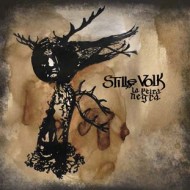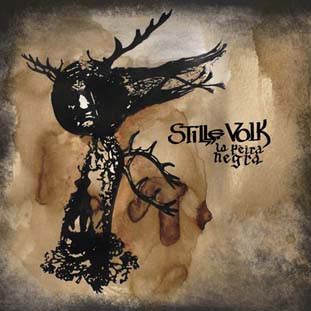 “It’s like village music” was the comment from the other end of the room where I was listening to this album. For sure “La Pèira Negra” sounds like a group of people have gathered with their multitude of mediaeval and Celtic instruments to play their music while others dance round maypoles in flowing robes. Yet as with Celtic-type folk in general, there’s a darker element hiding in the mysticism of the songs. Its atmosphere and acoustic elements reminded me of Finntroll’s “Visor om Slutet” (2003) in particular. But this is a collection of unique songs which themselves flow like that robe and at times can be like an instrumentation identification exercise. My particular favourite is the trumpet, which turns up to take us out of the traditional crackling fire in the forest and transports into the dusty, hot town square.
“It’s like village music” was the comment from the other end of the room where I was listening to this album. For sure “La Pèira Negra” sounds like a group of people have gathered with their multitude of mediaeval and Celtic instruments to play their music while others dance round maypoles in flowing robes. Yet as with Celtic-type folk in general, there’s a darker element hiding in the mysticism of the songs. Its atmosphere and acoustic elements reminded me of Finntroll’s “Visor om Slutet” (2003) in particular. But this is a collection of unique songs which themselves flow like that robe and at times can be like an instrumentation identification exercise. My particular favourite is the trumpet, which turns up to take us out of the traditional crackling fire in the forest and transports into the dusty, hot town square.
Stille Volk, who come from the French Pyrenees region, have been around for 20 years. “La Pèira Negra” is their 6th album, so natural as it all sounds, it is as you’d hope a well-oiled machine. The album opens up with the combination of the mandolin, a constant and insistent drum beat and rich vocals. “Dementis Maudicon” is hypnotic and exotic. It’s never hey-nonny-nonny but it combines lightness of touch with the European traditions of deeper mediaeval Celtic folk. This applies to the album as a whole. The drum is especially noticeable, imposing itself in an unobtrusive way and allowing the rest of the instruments to float around us. The subtlety is astounding. On “Sous l’Oeil de la Lune” the flute sends out haunting waves yet it’s not melancholic. The chorus suggests courage and resilience. At this point it is like sitting in a forest waiting for a battle. Then the trumpet appears and changes the perspective, while adding an exotic ingredient. The mystic journey continues with “”L’Eveil du Spectre”. The drum beat keeps our toes tapping as a mysterious journey takes place amid imaginary winds. It’s dark. The trumpet takes on a different dimension. There is laughter. Strange and indistinct sounds can be heard. It’s interesting. The title track is dark and suggestive, as it would be with that vast range of mediaeval sounds and instruments, which combine to develop into an imposing avant-garde mix. “La Litanie du Pétrifié” is a flute-led song, evoking camp fires, forests and a mood of defiance more than most others. We are then reminded on “La Forêt Gorgone” of Stille Volk’s mastery of a complex range of instruments, but this time we’re dancing round maypoles. The deep-voiced Frenchmen help to create the perfect balance between the dark and the light atmosphere, which this time the trumpet helps to create. The fiddle then meets the trumpet on “En Occulz”. The combination of the two creates a magic air. We are taken round the maypole once more. There’s an anarchy about the instrumentals yet “En Occulz” is completely hypnotic, catchy and sublime. And that’s where it should have ended as I had this delightful song going round and round in my head. Instead the album is completed with “Come to the Sabbath”, a Mercyful Fate cover. It’s decently done but we’d been taken into a magical world and now we were somewhere else. I’d rather have lingered in the world of “En Occulz”.
Each song is different on this album, yet there is an overall feel which made me want to be part of this village festival. At the same time it’s dark. Musically it’s complex, yet Stille Volk have created in “La Pèira Negra” a creative album which is easy to listen to, and one which fires the listener’s imagination.
(8.5/10 Andrew Doherty)
www.stillevolk.org

Leave a Reply